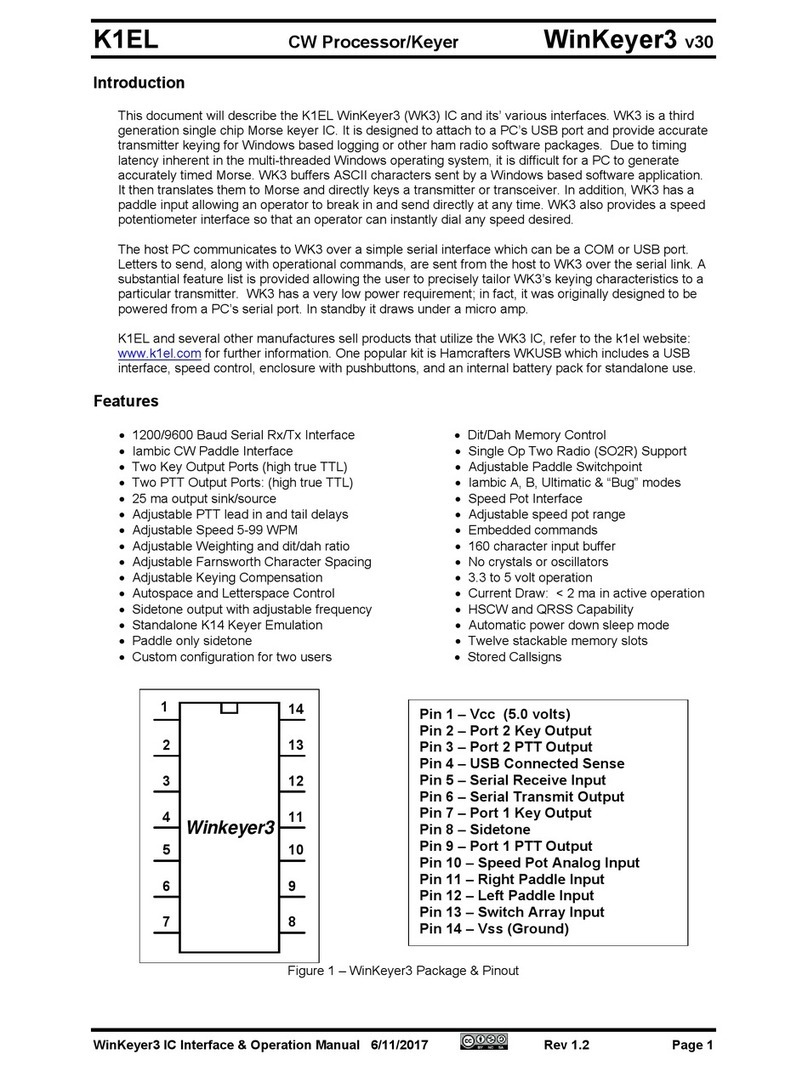
Introduction
This document describes the assembly, checkout, and hook up of the K1EL WinKeyer3 Serial Kit
with a version R01 PCB. This keyer is powered directly off the PC’s serial port and does not
require an external power source. Current draw is minimal, a low dropout, low quiescent current
3.3V voltage regulator helps in this regard. Open collector keying and PTT outputs are provided
as well as speed pot and iambic paddle interfaces.
WK3 Serial PCB Bill of Materials
__ R1, R2, R3, R5 4.7K ¼W resistor (yellow violet red)
__ R4, R6 470 ohm ¼W resistor (yellow violet brown)
__ RN1 6 pin 4.7K SIP bussed resistor network
__ Rx 10K Linear Taper Speed potentiometer
__ Q1 2N3906 PNP transistor TO92
__ Q2 2N3904 NPN transistor TO92
__ Q4 PN2222A NPN transistor TO92
__ Q3, Q5 2N7000 MOSFET TO92 (2N2222A may be substituted)
__ D2, D5 BAT42 Schottky Diode
__ D1, D3 1N4148 silicon diode
__ D4 LED
__ VR1 ST L4931CZ33 or equivalent TO92 3.3V LDO Regulator
__ U1 WinKeyer3 PIC processor (serial WK version)
__ C2, C5 .1 uF ceramic capacitor (104)
__ C3 22 or 33 uF electrolytic capacitor
__ C1, C4, C7, C8 .001 uF ceramic disc capacitor (102)
__ C6 .0047uF dipped ceramic capacitor (472 blue)
__ J1 DB9 9 pin female D connector
__ S1 14 pin DIP socket
Kit Assembly
1) Verify and check off components against the bill of materials listed above. If there are any
parts missing, notify K1EL by email and we will send them to you.
2) The WK3 Serial PCB does have a solder mask but it is quite easy to inadvertently bridge
two etches or pads together. 95% of all kits returned for repair have had soldering errors.
3) Use the pictures on pages 4 and 5 to help identify components and where they go.
4) Carefully check the PC board for any defects, although it’s very rare it has happened.
5) Follow the silkscreen and carefully install all six resistors (R1 – R6) then solder and trim
leads. Note that the 470 ohm resistor (yellow violet brown) is easily confused with the
4.7K resistors (yellow violet red).
6) Install resistor network RN1, pin one of the network is marked with a dot. If you are
unsure you can verify pin one with an ohmmeter. You will measure 4.7K between pin 1
and 2. Between pin 5 and 6 you will measure 9.4K. Orient the network so that pin 1 goes
into the square pad.
7) Observe polarity band markings and install diodes D1, D2, D3, D5. Solder and trim leads.
WK3 Serial Assembly Guide Version R01 – 3/10/2021 Page 2




























